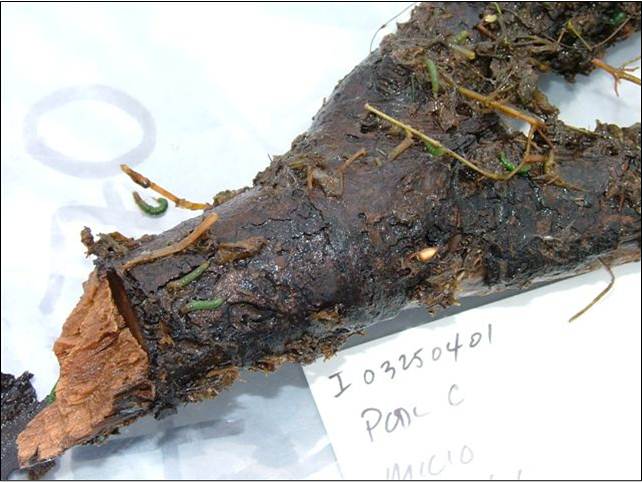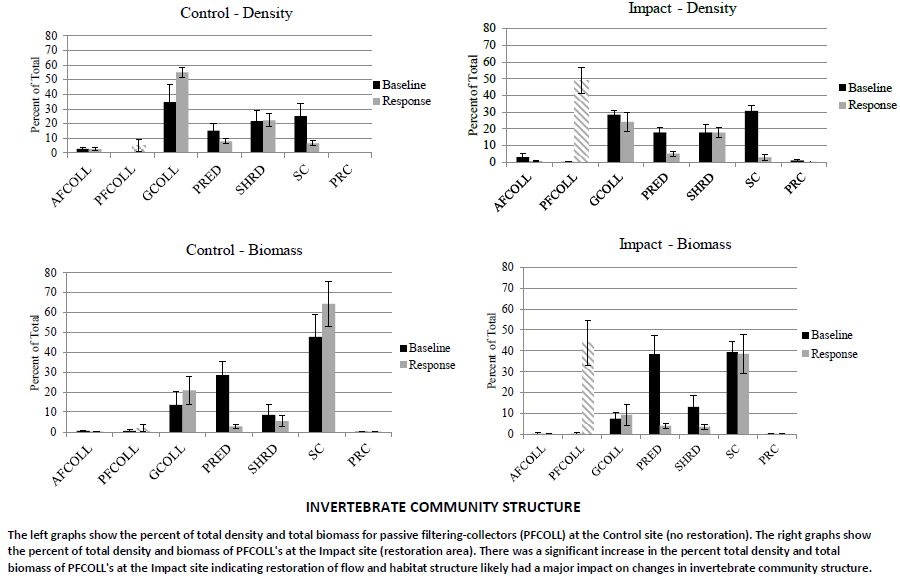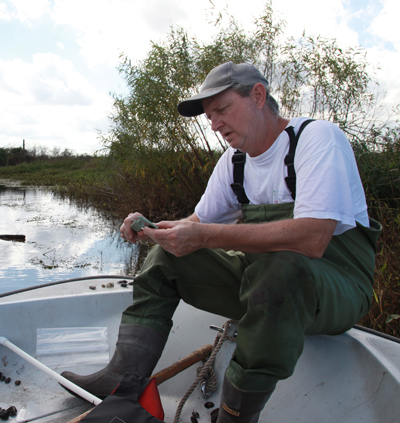 Joe Koebel is the lead Senior Environmental Scientist on the Aquatic Macroinvertebrate Studies that are conducted as part of the Kissimmee River Restoration Project. The SFWMD has set up a series of Performance Expectations that guide the scientists in their research objectives. So far, the Kissimmee River Restoration is meeting the SFWMD’s research expectations. Four of the 25 restoration expectations are based on the recovery of macroinvertebrate communities in the restored Kissimmee River. The Expectations that Joe’s research supports are:
Joe Koebel is the lead Senior Environmental Scientist on the Aquatic Macroinvertebrate Studies that are conducted as part of the Kissimmee River Restoration Project. The SFWMD has set up a series of Performance Expectations that guide the scientists in their research objectives. So far, the Kissimmee River Restoration is meeting the SFWMD’s research expectations. Four of the 25 restoration expectations are based on the recovery of macroinvertebrate communities in the restored Kissimmee River. The Expectations that Joe’s research supports are:
To quantify these expectations the Kissimmee River research and monitoring studies that Joe leads are:
Responses of Snag Dwelling Macroinvertebrates – Restoration Results are Exciting!
Natural free-flowing river systems of the southeast US generally support a guild of aquatic invertebrate known as “passive filtering-collectors”. These invertebrates have structural or behavioral adaptations that allow them to trap fine organic matter (i.e., food) as it travels downstream in the current. This guild usually accounts for the greatest proportion of mean annual invertebrate density and biomass in these natural systems. Following channelization of the Kissimmee River and elimination of flow, this important invertebrate guild was almost eliminated from the river.
Under channelized conditions, mean annual density and biomass of passive filtering-collectors was approximately 41 individuals/m2 and 5 mg/m2, respectively. Following river restoration and reestablishment of flow, passive filtering-collectors rapidly colonized newly available habitat on large woody debris. Recent studies indicate that mean annual density and biomass of passive filtering-collectors in the restored system have increased to over 8000 individuals/m2 and almost 800 mg/m2 . This increase is very strong evidence that restoration of flow and habitat structure has been the impetus for restoration of this important invertebrate indicator guild in the Kissimmee River. Results are illustrated in the graph below:

Joe thinks, “One of the most rewarding aspects about working with the SFWMD and Kissimmee River Restoration Project is the opportunity to see an ecosystem that had been destroyed as a result of flood control efforts, return to its former glory! Witnessing the return and restoration of native fish and wildlife communities while continuing to maintain flood control has been a remarkable experience. The opportunity to collaborate with outstanding scientists, engineers, geographers and technicians from the SFWMD and other agencies has been a great learning opportunity and very rewarding.”
About Joe Koebel:  Joseph Koebel is a Senior Environmental Scientist that has been working at the South Florida Water Management District (SFWMD) for over 25 years. Joe has been part of the Kissimmee River Restoration research team since the beginning and leads the macroinvertebrate studies. During this time, he has seen the river transform from the sterile C-38 canal back to a more natural free-flowing river with abundant fish and wildlife. River runs that were choked with vegetation are now clear. Large deposits of organic matter on the riverbed have been replaced by a natural shifting sand substrate. Dissolved oxygen levels within the river have increased from critically low levels (often near 1.0 mg/L) to levels typically found in natural black water rivers of the southeast (generally in the 3-6 mg/L range). All of these factors have played a role in the response and restoration of the aquatic invertebrate community.
Joseph Koebel is a Senior Environmental Scientist that has been working at the South Florida Water Management District (SFWMD) for over 25 years. Joe has been part of the Kissimmee River Restoration research team since the beginning and leads the macroinvertebrate studies. During this time, he has seen the river transform from the sterile C-38 canal back to a more natural free-flowing river with abundant fish and wildlife. River runs that were choked with vegetation are now clear. Large deposits of organic matter on the riverbed have been replaced by a natural shifting sand substrate. Dissolved oxygen levels within the river have increased from critically low levels (often near 1.0 mg/L) to levels typically found in natural black water rivers of the southeast (generally in the 3-6 mg/L range). All of these factors have played a role in the response and restoration of the aquatic invertebrate community.
As a teenager, Joe was an avid fisherman and became interested in aquatic insects as they related to fish/invertebrate predator-prey interactions. Following his interests, Joe pursued and received a B.S. in Fisheries and Wildlife Science from North Carolina State University and immediately continued his education at The University of Alabama where he received a M.S. in Biology. Joe began his career at the SFWMD in 1991 as a Senior Scientific Technician. He was soon promoted to Staff Environmental Scientist, Senior Environmental Scientist and Senior Supervising Environmental Scientist. Aside from his work with aquatic insects, Joe assists with the amphibian/reptile research and fisheries studies.
Joe’s favorite study is “Response of Benthic and Snag-dwelling Macroinvertebrates to Restored Flow in the Kissimmee River ”. The response to the restored river by aquatic macroinvertebrates tends to be quite rapid. We are able to tell very quickly whether the river system and aquatic invertebrate communities are responding according to our expectations. It is exciting to see key indicator species returning to the river in large numbers! It is always great to discover an invertebrate that has not been found in the river for nearly 50 years. For example, Cheumatopsyche spp. (Trichoptera: Hydropsychidae), a net-spinning caddisfly that was eliminated from the river following channelization and loss of flow in the 1960s, has returned in large numbers! It now makes up the greatest proportion of macroinvertebrate density and biomass on snags (woody debris) in the river.
When asked his advice to students interested in pursuing a career in environmental science, Joe thinks, “You should use your time in school to explore different aspects and areas of environmental science. Take as many different courses (botany, entomology, herpetology, ichthyology, ornithology, soil science, etc.) as you can. If you find something that you love, then you can focus on it in your Junior and Senior years. It is important to have a good general understanding of many different fields of study. If possible, think about pursuing a post-graduate degree. That is where you can really hone your skills. The extra work will benefit you in the long run.”
Learn more about other scientists working on the Kissimmee River: